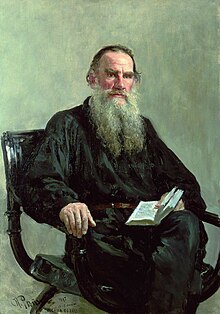Leo Tolstoy
Count Lev Nikolayevich Tolstoy (9 September 1828 – 20 November 1910) was a Russian novelist and anarchist, famous for writing the books War and Peace and Anna Karenina, and many other works. He was a Christian and believed in non-violence and practiced simple living. His work The Kingdom of God is within you has influenced people like Mahatma Gandhi and Martin Luther King.
Leo Tolstoy | |
|---|---|
![Tolstoy on 23 May 1908 at Yasnaya Polyana,[1] Lithograph print by Sergey Prokudin-Gorsky](http://upload.wikimedia.org/wikipedia/commons/thumb/c/c6/L.N.Tolstoy_Prokudin-Gorsky.jpg/220px-L.N.Tolstoy_Prokudin-Gorsky.jpg) | |
| Native name | Лев Николаевич Толстой |
| Born | 9 September 1828 Yasnaya Polyana, Tula Governorate, Russian Empire |
| Died | 20 November 1910 (aged 82) Astapovo, Ryazan Governorate, Russian Empire |
| Resting place | Yasnaya Polyana, Tula |
| Occupation | Novelist, short story writer, playwright, essayist |
| Language | Russian |
| Period | 1847–1910 |
| Literary movement | Realism |
| Notable works | |
| Spouse | |
| Children | 13 |
| Relatives |
|
| Signature | |


Early life
changeTolstoy was born at Yasnaya Polyana, the family estate in the region of Tula, Russia and he married Sofia Andreevna Bers.
Death
changeTolstoy died in 1910, at the age of 82. He died of pneumonia.
Life and career
changeWhen he was young his parents died, so he and his siblings were brought up by relatives. At the age of 16, he began studying law and oriental languages. Unfortunately, he left University in the middle of his studies and spent much of his time in Moscow and Saint Petersburg. Later on in his life, he joined the Army with his brother after running up some heavy gambling debts. It was at that time that he started writing.
His conversion from a wealthy society author to the non-violent and spiritual anarchist of his later days was notable. It was caused by his experience in the army as well as two trips around Europe in 1857 and 1860–61. Others who followed a similar path were Alexander Herzen, Mikhail Bakunin and Peter Kropotkin. During his 1857 visit, Tolstoy saw a public execution in Paris, an experience which marked the rest of his life.
After Anna Karenina, Tolstoy concentrated on Christian themes, and his later novels such as The Death of Ivan Ilyich (1886) and What Is to Be Done? (1886) develop a radical Christian philosophy which led to his excommunication from the Russian Orthodox Church in 1901.[2]
After shaping both his political and literary development in Europe, he returned to Russia and founded 13 schools for Russia's peasant children.[3]
Related pages
changeReferences
change- ↑ "Tolstoy in Color", Tolstoy Studies Journal, a publication of the Tolstoy Society of North America, n.d. Retrieved 27 June 2018.
- ↑ Church and State. L Tolstoy – On Life and Essays on Religion, 1934.
- ↑ Wilson A.N. 2001. Tolstoy. New York:Norton. ISBN 0-393-32122-3
- ↑ "Leo Tolstoy Quotes". Motivators. 4 February 2021. Archived from the original on 21 August 2022. Retrieved 21 August 2022.